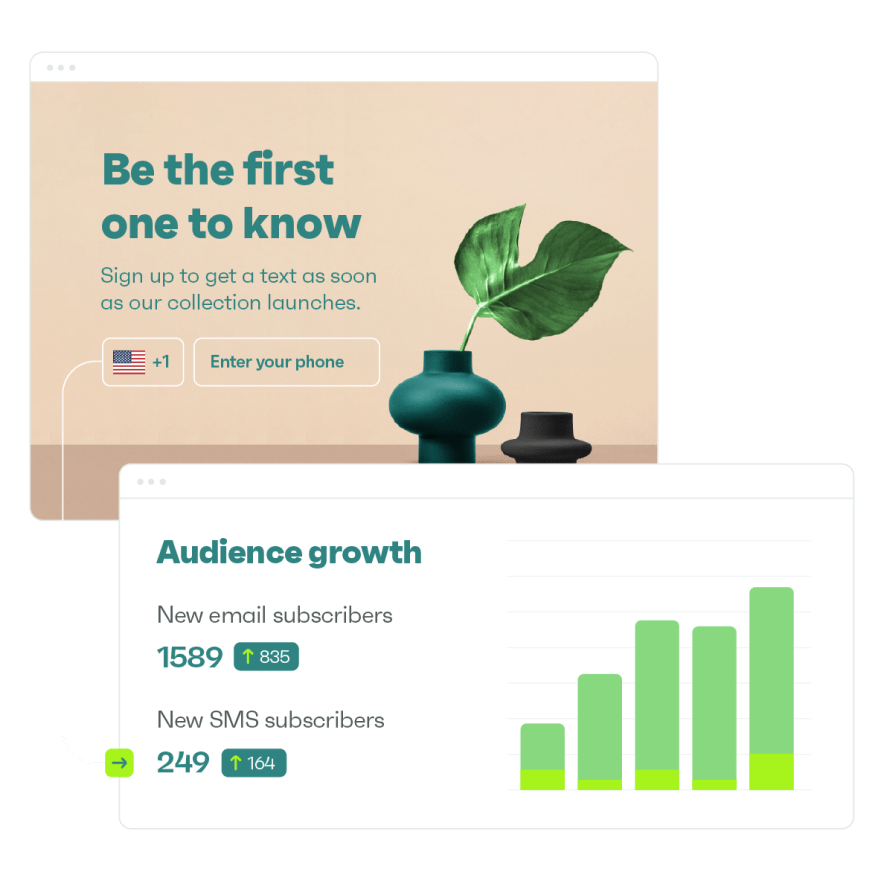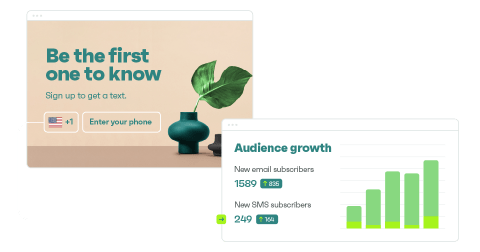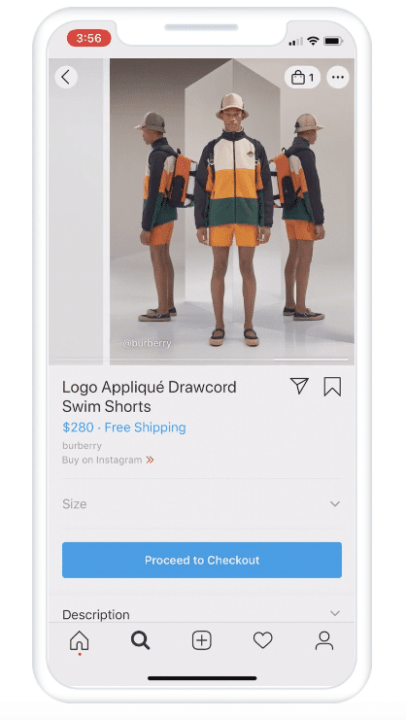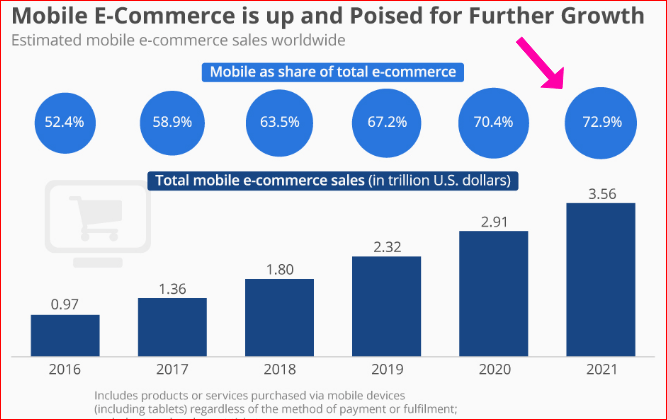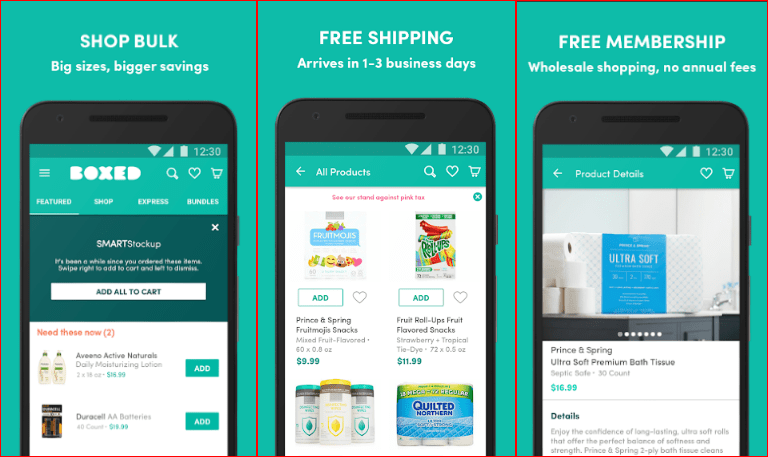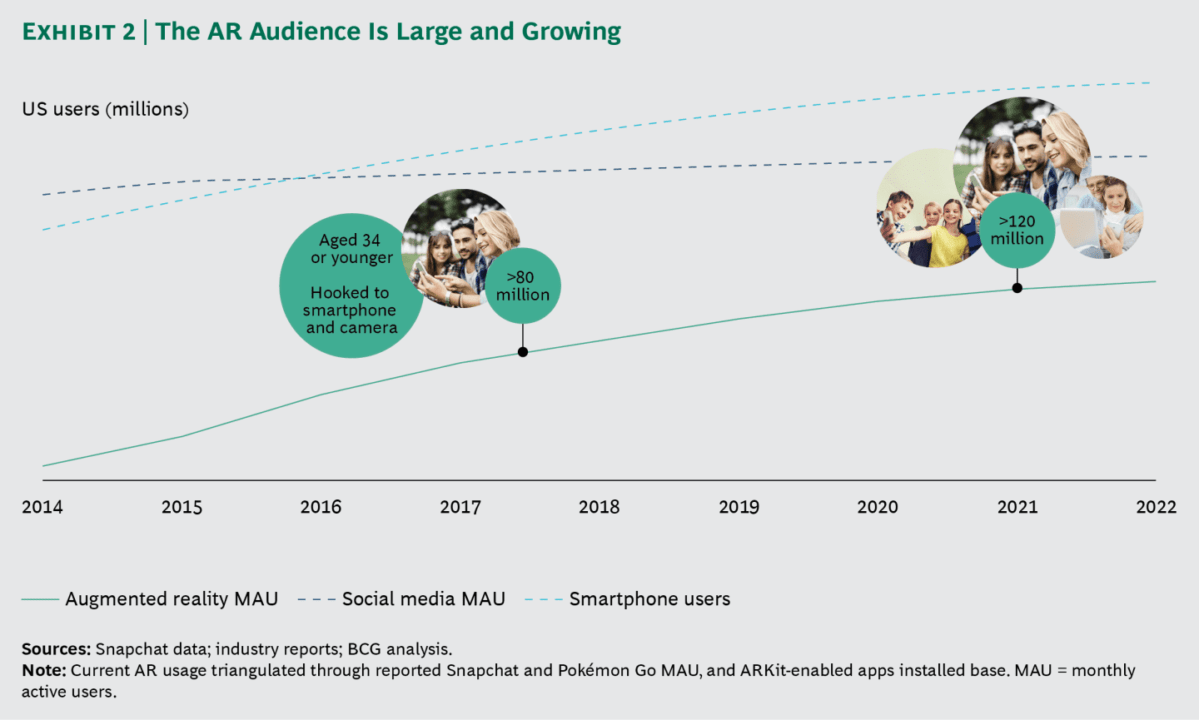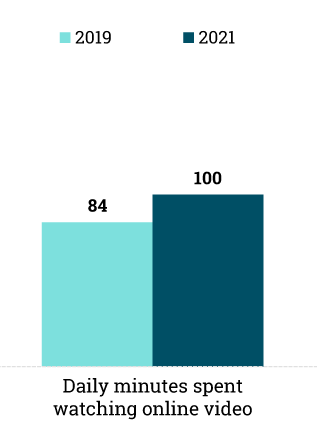Drive sales on autopilot with ecommerce-focused features
See FeaturesThe ultimate guide to mobile commerce for better sales
In the ever-changing world of modern business, one thing has always been certain: consumer demand is constantly shifting towards online shopping.
There are many benefits of this choice—consumers don’t have to leave the comfort of their own homes, they can have access to different product variations, they get products shipped any address, and so on.
As a business owner, when you are struggling to obtain new customers, having an online presence is not a choice.
This is where mobile commerce (or m-commerce) helps in aligning you and your customers in a single frame.
Due to the pandemic, mobile shopping has now become the new norm—by 2025, mobile commerce is expected to make up 44.2% of retail ecommerce sales in the US.
So you can be pretty sure that m-commerce is going to be the next big thing. In fact, pretty soon mobile commerce sales could become your main source of revenue.
But before diving into the nitty-gritty of m commerce, let’s find out what exactly this is.
What is mobile commerce?
As you may know, mobile commerce involves selling or purchasing goods through the use of mobile devices. Essentially, they’re about mobile purchases for ecommerce.
With the increased number of smartphone users, people are spending more time on mobile applications: almost 4.2 hours have been spent on mobile apps per day.
And with more time on their phones, more people are naturally shopping using those phones. In fact, 55.4% of the global population purchased something via mobile devices in the last quarters of 2020.
To push m-commerce forward, social media brands (for example, Facebook, Instagram, Pinterest) are constantly trying to engage people with features like integrated ecommerce shops and shoppable posts. They’re hoping that most of their mobile audience don’t leave the platform without clicking the buy button, and also pushing for mobile payment.
Any ecommerce brand with a social presence can take advantage of those features to get orders from customers—as long as they provide a mobile friendly experience.
Since mobile commerce provides a convenient shopping experience to consumers, most businesses have come to know a lot more about their customers’ behaviors.
For example, when customers get into your mobile application or your integrated social media shop, you get a chance to interact via hyper-personalized tools like push notifications, chatbots, SMS, or email—an opportunity for future customer engagement, leading to brand loyalty due to the multiple touchpoints.
Mobile commerce helps make this hyper-personalized, omnichannel approach much easier as customers can be communicated throughout the entire journey through their phones.
Your customer, in essence, is always ready to be captivated by your products and your messaging. If you play your cards right, you can seriously boost your incoming mobile purchases.
The difference between mobile commerce and ecommerce
While there are a few ways in which they overlap, there are a few differences between mobile commerce and ecommerce.
(Essentially, here we’re looking at the difference between mobile commerce and the ecommerce that’s happening on desktop or laptop.)
Some of the differences:
- Ecommerce is the shortened form for “electronic commerce,” while mobile commerce can be shortened to m-commerce
- Ecommerce (on desktop or laptop) doesn’t offer a lot of the same portability and usability that m-commerce does, making it less convenient in some ways
- Tracking capabilities are limited for ecommerce, but with the help of GPS technology, it’s easier to track users for mobile commerce. This is important to remember for your separate mobile marketing strategy
- Push notifications can reach users more directly on mobile commerce than for (desktop and laptop) ecommerce.
- Security measures for mobile commerce are more extensive, such as two-factor and multi-level authentication, and even the biometrics (fingerprints and face recognition)
While these are only some of the differences, these are important to remember how m-commerce differs and why you should consider it separate from regular ecommerce.
Why choose mobile commerce?
Believe it or not, m-commerce has already taken up the majority of global ecommerce sales: almost 73% of global sales are set to come from m commerce in 2021 alone.
Let’s look in depth at some unmissable advantages of m-commerce:
Great user experience
There is no denying that user experience matters. After all, customers come to you in the hope of getting their problems solved by your products or services. So, it’s important to make things easier for them with mobile marketing—from your page speed to navigation or design.
It’s important to ensure everything is working smoothly.
If there are any mobile shoppers issues they will most likely hurt your overall conversion rates. The more friction you reduce, the better opportunity you create not only to revamp the conversion rate but to grow a loyal user base.
Beauty brand Glossier is a perfect example of making its user experience smooth and user-friendly.
The design is visually appealing and gives customers a choice to change different shades of their preferred items with a few clicks. When they add a product to their bag, they are encouraged to get free shipping too.
Omnichannel marketing opportunities while getting valuable data
With the aid of m-commerce, you have the opportunity to create a unified and seamless customer journey so that mobile shoppers can make the transition from the browser state to the buyer state more quickly.
This transition is best served by incorporating m commerce into an omnichannel approach.
The omnichannel approach is simple—sharing a consistent message on multiple channels while understanding their behavior, and also giving them the same shopping experience through those different channels like email, SMS, or push notifications.
Throughout the whole customer journey, people take countless actions such as clicking on your site, browsing through different pages, comparing different products, subscribing to grab a coupon code, or even downloading a free ebook.
This simply means they are sharing their valuable data with you. You should use this data to gain a competitive advantage over other top platforms as well.
For instance, the shared email addresses, demographics, or browsing history can be used to craft a killer Facebook ad to attract a lookalike audience, or you can use that to retarget those first-time buyers to be your repeat customers.
Even from the analysis of 135,000 campaigns sent in 2021, we found that businesses using several channels as the means of their omnichannel campaigns earned a 494% higher order rate than single-channel campaigns.
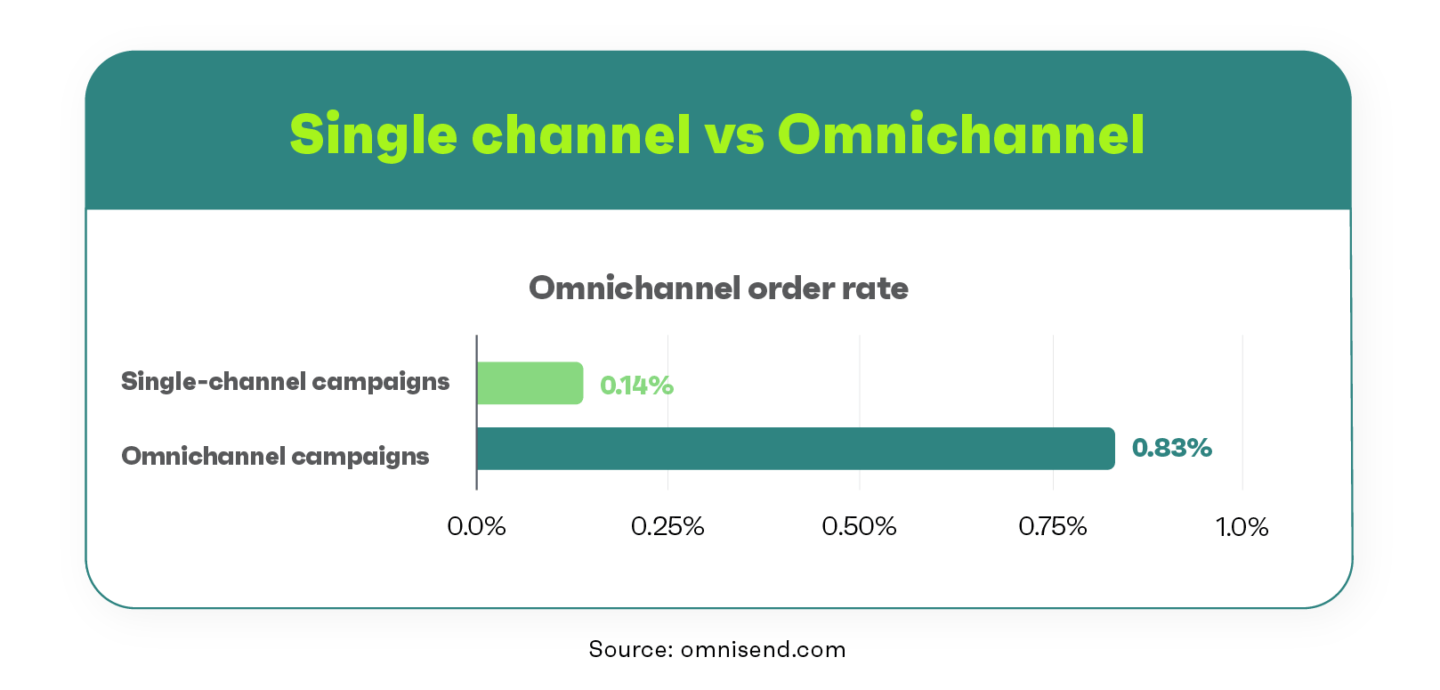
Instant transaction
On average, 69.99% of online shopping carts are abandoned during the checkout process. But mobile commerce can be your saving grace due to the availability of different payment options that are specifically designed to better serve smartphone users.
People can now instantly pay with their mobile wallets without having to enter their card details. A click or two is sufficient to make the checkout process seamless—this is what popular payment options like Apple Pay, Google Pay, Amazon Pay, PayPal’s One-Touch, and Visa Checkout help users do.
But if you are overwhelmed about what options to go after, start by spying on your competitors to crack the code (if something is common on your competitors’ apps, this could be a signal to apply it to your own store).
Personalized content
Now that you’ve collected your customers’ data, it’s time to send personalized content for your m commerce strategy. That way, you can make mobile shoppers feel special by sharing their preferences. In most cases, knowing those preferences means increasing brand awareness and loyalty.
One of the best methods to send personalized content is product recommendations.
Based upon their recent purchases, sometimes displaying similar items that they really need is more tempting than offering a flat 70% off (that’s what most ecommerce brands usually do to get their sales going).
Showing customers your newly released items is another personalized technique you can use to get repeat buyers.

Amazon, for example, lets everyone follow the authors and will notify them with the new releases. If you are about to release any new items in your ecommerce store, you should create a separate page for those new releases.
Your personalization doesn’t stop only on the product recommendation or the new product releases either. You will need to have other mobile marketing strategies in place to boost your ecommerce engagement rate.
Sending an email campaign to your segmented list can be a superpower in this case.
Hawaiian Airlines is a prime example that makes the most of a personalized email campaign for one of its customers.
Mobile commerce examples
Now, since you have a clear idea of what mobile commerce is and why it matters, let’s look at 3 killer examples of m-commerce:
Boxed
Boxed (an online wholesale retailer) has some ingenious ways to solve their customers’ problems in their m-commerce app.
When customers run short on something, its ‘Smart Stock Up’ feature sends a reminder and people can instantly re-order their needs with a few taps via m commerce.
Apart from this feature, customers can earn some awesome perks like shopping in bulk and 1-3 day free shipping with their free membership plan.
Wayfair
The home decor ecommerce brand offers more than 14 million items across home furnishings, decor, housewares, and more. They are constantly improving the way people shop online, from product discovery to easy checkout.
Due to their rapidly increasing mobile customers, they’re always coming up with new features to do exactly that (revamp the shopping experience).
This brand also provides customers with some awesome features—from creating a virtual 3D room to interactive photos.
With advanced technology like AR, customers can now try on virtually every product without going in-store shopping.
Even if they don’t want to buy now and want to try something in the next month, these can be saved as favorite finds.
Target
Another example of mobile commerce is Target. This retail brand steps into the world of applications to give a convenient shopping experience akin to their physical stores.
For instance, when customers sign up to the mobile app, they get immediate access to its circle feature, which allows them to grab some tantalizing deals in a flash, and they receive the following perks too:
- Any order can be brought to the customer’s car with their Drive Up feature.
- Save and pay in a single scan with Target’s Wallet
- Same-day delivery
Mobile commerce trends
As m-commerce continues to expand, these are the 5 trends you should keep an eye on:
Voice shopping
The rise of voice search assistants like Alexa, Siri, or Google Assistant has presented opportunities for smartphone users to search without needing to physically interact with their phone.
As it’s also natural that we speak faster than we type, people are turning to the voice assistant more than ever. Not paying attention to this growing trend can be a mistake while you are just planning to step up to the mobile commerce strategy.
Here’s the reality though: voice shopping (ecommerce transactions via voice assistants) is set to bring in $19.3 billion in 2023, and those will be based on some form of mobile purchases.
As an ecommerce brand, you want to have a healthy chunk of that revenue. Optimizing your keywords for voice search is a must to get the ball rolling.
Chatbot
Chatbots are one of the best solutions to provide instant customer service without requiring time from your support team 24/7. By integrating this tool, brands will always be a step ahead to better serve their audience.
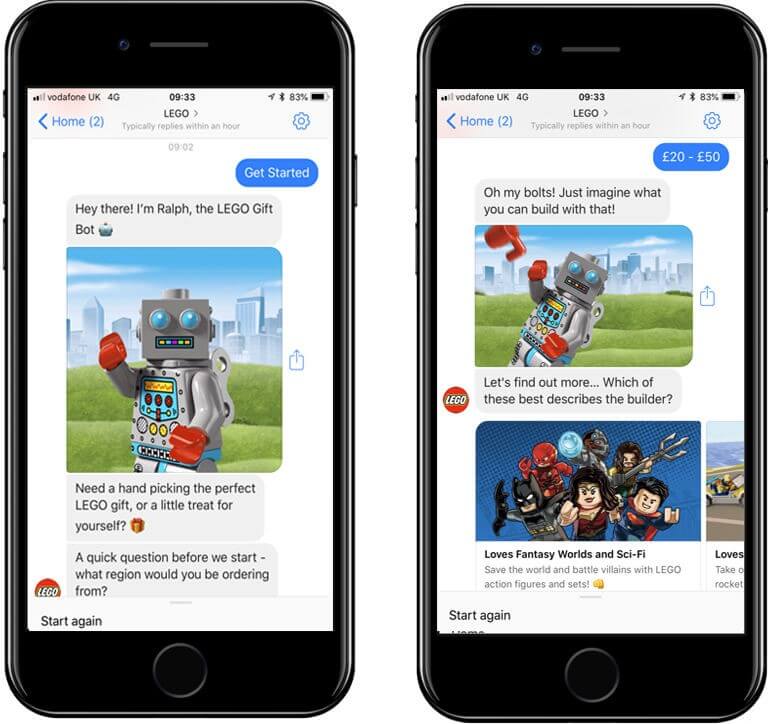
This tool does a few things for you:
- Leads to happier and more satisfied customers.
- Helps you understand customer pain points to improve your future products and services.
- Reduces your customer service costs.
- Generates more email subscribers on autopilot.
- Helps in educating customers about your products outside of these heavy mediums like blogs, videos, guides, etc.
The chatbot industry is expected to reach $112 billion by 2023. They’re also pretty mobile friendly, meaning a wonderful experience for your mobile shoppers.
Push notifications
Push notifications are nothing but pop-up messages that appear on your customers’ smartphones. The best part—they don’t have to open your app or browse your ecommerce site to get notified. As long as they have opted-in and their phones are on, you can send them whatever you want.
But make sure your messages are concise and to the point. Otherwise, you might end up getting a lower conversion rate. Messages containing 10 or fewer words can produce the best conversions (or click rates in this case).
When it comes to messages, you might be wondering what you should be sending them, right?
With the help of your creativity, you can use the data you collected to craft high-converting messages.
For instance, if a customer has recently purchased something and is waiting to get his product shipped, forward a simple push message to let him know when it will arrive.
Since 48% of customers purchase something after receiving a push notification, you should take this into account for your mobile commerce application.
Augmented reality
These days people want to visualize or experience products in real-time before hitting the buy button, and that’s what you can make possible using AR. Augmented reality is a technology that is being used to enhance the product visualization and its experience in a way people are used to with traditional brick-and-mortar stores.
By now, more than 120 million U.S. consumers have engaged with AR. As an ecommerce brand, providing a smooth product experience with this advanced technology could increase the engagement rate, resulting in higher product sales.
The following places where you will see AR in action:
- Virtual try-out solutions
- Preview placement
- Interactive manuals
- Social media filters
Implementing AR helps your audience better understand your products and simultaneously influences their buying decisions.
Increase in video content
Over the past few years, content marketing has experienced huge changes, and video has come out front-and-center: it’s one of the best marketing content types you can use to connect with your audience.
The average person now spends 100 minutes every day consuming online videos (a 19% hike from 2019).
Not only do videos secure a lot of fresh eyeballs but the usage of videos on landing pages increases the conversion rate by 80% as well.
Having a video marketing strategy in place is something you will need for your mobile commerce growth.
With videos, you can demonstrate almost everything about your products such as how to use them, their best features, product comparisons, some behind-the-scenes, or you can even tell them about your brand mission.
This strategy will also pave the way to gain trust among those who are unfamiliar with your brand. Furthermore, over 50% of shoppers admit that online videos help them to decide which brand they should buy from.
Wrap up
With the increased demand for smartphones, you can easily realize that mobile commerce is not a ‘nice to have’ right now—it’s now become a ‘must have.’
With the right knowledge and implementation, it’s a surefire way to get on top of your competitors and have amazing sales. Omnichannel solutions like Omnisend that can incorporate m-commerce will be something that you need to speed up the process.
quick links
related features
No fluff, no spam, no corporate filler. Just a friendly letter, twice a month.
